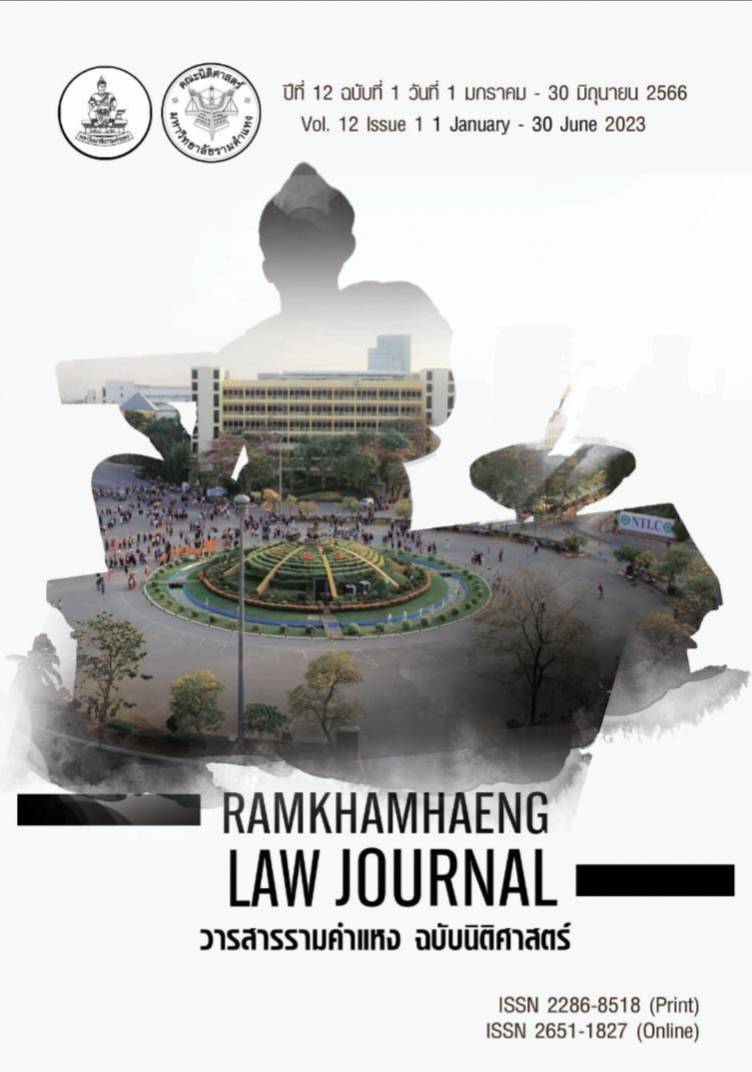The Extension of Additional Protection under the Aspect of Geographical Indications (GI) Law to Cover Coffee: A Case Study of Thailand
Main Article Content
Abstract
Coffee is among the beverage with the highest consumption rate in the world. Despite the complexity of coffee plantations, coffee production has been increasing over the past decades. This phenomenon later led to the geographical indications tags which emphasized the environment where coffee is being grown and coffee bean processing techniques which is unique in each location. With respect to the current geographical indications law under the World Trade Organization (WTO) Agreement on Trade-Related Aspects of Intellectual Property Rights (TRIPS) which is also concerning the protection of the products with the uniqueness in geographical regions, the additional protection only provides to certain product namely wine and spirits. Accordingly, many countries come up with the suggestion to extend such additional protection to cover coffee products. However, it is still debatable among the member states whether it is necessary to implement such extension since some has argued that general protection is adequate enough. This research found that in particular countries and areas, namely European Union (EU), Japan and Thailand where coffee plays certain significant role in the economy, the relevant law on additional protection still does not cover coffee products. In order to maximize the economic value of coffee products and to reflect the true intention of the geographical indications law, the additional protections should be extended to cover coffee products as well.
Article Details

This work is licensed under a Creative Commons Attribution-NonCommercial-NoDerivatives 4.0 International License.
References
Addor F. Thumm N. and Grazioli A. “Geographical Indications: Important Issues for
Industrialized and Developing Countries.” Institute for Prospective
Technological Studies (IPTS) Report, 74 (2003): 24-31.
Ake-Yokaya, Thanakrit . Expert on Geographical Indication. Interview. 25 March 2021.
Arfini F. and Bellassen V. Sustainability of European Food Quality Schemes. New York:
Springer, 2019.
Barjolle D, Xiomara and others. “The Role of the State for Geographical indications of
Coffee: Case Studies from Columbia and Kenya.” World Development 98 (2017): 105-119.
Bérard L. and Marchenay P. “Localized products in France: definition, protection and
value-Adding.” From local food to localized food, Anthropology of food 2
(2007): 19-21.
Bongo, Adi. “Intellectual property rights in biotechnology and the fate of poor farmers’
Agriculture.” Journal of World Intellectual Property 9, 1 (2006): 91-112.
Bunn C. and others. “A bitter cup: climate change profile of global production of
Arabica and Robusta coffee” Climatic Change 129 (2015): 129-189.
Changthaworn, Thanit . Deputy Director of Biodiversity-Based Economy
Development Office (Public Organization: BEDO). Interview. 11 June 2021.
Frantz F. “Twenty Years of TRIPS, Twenty Years of Debate: The Extension of High Level
Protection of Geographical Indications – Arguments, State of Negotiations and Prospects.” Annual Survey of International & Comparative Law 21, 1 (2016): 93-117.
Guimaraes E. and others. “The brand new Brazilian specialty coffee market” Journal
of Food Products Marketing 25, 1 (2018): 49-71.
Intellectual Property Division Food Industry Affairs Bureau, Ministry of Agriculture,
Forestry and Fisheries. “Geographical Indication Protection System Guidelines
for the Use of Geographical Indications.” 2015.
Ministry of Agriculture, F. a. F. Geographical Indication (GI) Protection System in
Japan [Online]. Available URL: https://www.maff.go.jp/e/japan_food/gi_act/pdf/gi_
pamph.pdf, 2020 (February, 22).
_______. Tokutei Norin Suisan Butsu to no Meisho no Hogo ni Kansuru Horitsu
[Act for the Protection of the Names of Designated Agricultural, Forestry
and Fishery Products and Foodstuffs.] [Online]. Available URL: http://www.
maff.go.jp/j/shokusan/gi_act/outline/pdf/doc4.pdf. 2020 (February, 22).
Ngokkuen C. and Grote U. “Challenges and opportunities for protecting geographical
indications in Thailand.” Asia-Pacific Development Journal 19, 2 (2012): 93-123.
Pattana bunpiboo, Weeranuch l. Director of Sales, Doi Tung Coffee. Interview. 1 April 2021.
Rangneker D. Geographical Indications: A review of proposals at the TRIPS Council:
extending article 23 to products other than wines and spirits. Geneva: International Centre for Trade and Sustainable Development, 2003.
Rao N. “Geographical Indications in Indian Context: A Case Study of Darjeeling Tea.”
Economic and Political Weekly 40, 42 (2005): 4545-4550.
Statista. Coffee Thailand [Online]. Available URL: https://www.statista.com/outlook/
/126/coffee/thailand#market-revenue, 2020 (July, 7).
Surbhi J. “Effects of the extension of geographical indications: a South Asian perspective.”
Asia-Pacific Development Journal 16, 2 (2009): 65-86.
Thanasanti, Pajchima. former Director General of Department of Intellectual Property,
Ministry of Commerce, Thailand. interview. 18 June 2021.
Trade Economy, Thailand: Imports and Exports of Coffee [Online]. Available URL:
https://trendeconomy.com/data/h2/Thailand/0901, 2020 (November, 15).
United States Department of Agriculture, F. A. S. Coffee: World Markets and Trade
[Online]. Available URL: https://apps.fas.usda.gov/psdonline/circulars/coffee.
pdf, 2021 (March, 3).
Vuthiparum, Jutatip . Professional Trade Officer at Department of Intellectual Property,
Ministry of Commerce, Thailand. interview. 16 June 2021.
Williams D. Extension of Stronger Geographical Indications Protection: Against the interests
of Developing Countries? [Online]. Available URL: https:// www.iprsonline.org
/ictsd/docs/WillamsBridgesYear6N4May2002.pdf, 2020 (November, 26).
World Trade Organization. Agreement on trade-related aspects of intellectual property
rights [Online]. Available URL: https://www.wto.org/english/docs_e/legal_e/
-trips.pdf, 2021 (February, 18).
_______. Background and the current situation [Online]. Available URL: https://www.
wto.org/english/tratop_e/trips_e/gi_background_e.htm, 2022 (February, 23).
______. Part II — Standards concerning the availability, scope and use of Intellectual
Property Rights [Online]. Available URL: https://www.wto.org/english/docs
_e/legal_e/27-trips_04b_e.htm, 2020 (November, 15).
Zou J. Rice and cheese, anyone? The fight over TRIPS geographical indications continues
[Online]. Available URL: https://www.brooklaw.edu/students/journals/bjil/ bjil30iii_zou.pdf, 2020 (January, 9).

